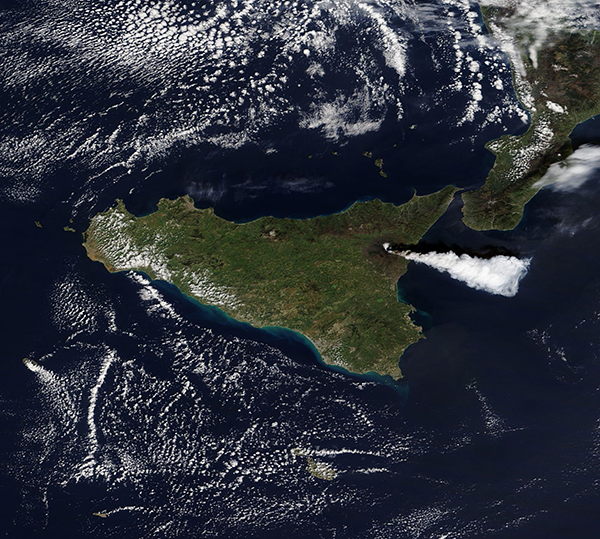Images
March 15, 2021 - Eruption at Mt. Etna
Tweet
On March 12, 2021, Italy’s Mount Etna erupted for the twelfth time in twenty-five days, sending a large plume of ash about 10 km (32,808 feet) into the atmosphere along with dramatic lava fountaining. The Moderate Resolution Imaging Spectroradiometer (MODIS) on board NASA’s Terra satellite acquired a true-color image on that same day which captured the large ash plume as it drifted eastward over the Ionian Sea.
There is nothing particularly unusual about Mount Etna flinging lava, volcanic ash, or molten rocks into the air. The Italian volcano ranks as one the most active in Europe and has been in a state of eruption since 2011.
This most recent paroxysm, which started on February 16, has been particularly violent. In February, lava fountains rose as high as 1.5 kilometers (0.9 miles), about 3 times the height of One World Trade Center, the tallest building in the United States. Columns of ash and small rock fragments (called lapilli) rose as high 11 kilometers (6.8 miles) in altitude. Long lava flows poured down Etna's eastern flank. Lapilli (rock fragments) and ash have landed in several cities and villages near the volcano in recent days.
Despite the extreme strombolian activity, the risk to people has been deemed as small. The Global Disaster Alert and Coordination System (GDACS) gave the eruption a “green” (low risk) alert, stating that the event is likely to have a low humanitarian impact. About 2.75 million live within 100 km (62 mi) of the volcano and 940,000 within 30 km (18 mi).
Image Facts
Satellite:
Terra
Date Acquired: 3/12/2021
Resolutions:
1km (358.8 KB), 500m (1008.7 KB), 250m (752.5 KB)
Bands Used: 1,4,3
Image Credit:
MO'DIS Land Rapid Response Team, NASA GSFC
Tweet
On March 12, 2021, Italy’s Mount Etna erupted for the twelfth time in twenty-five days, sending a large plume of ash about 10 km (32,808 feet) into the atmosphere along with dramatic lava fountaining. The Moderate Resolution Imaging Spectroradiometer (MODIS) on board NASA’s Terra satellite acquired a true-color image on that same day which captured the large ash plume as it drifted eastward over the Ionian Sea.
There is nothing particularly unusual about Mount Etna flinging lava, volcanic ash, or molten rocks into the air. The Italian volcano ranks as one the most active in Europe and has been in a state of eruption since 2011. This most recent paroxysm, which started on February 16, has been particularly violent. In February, lava fountains rose as high as 1.5 kilometers (0.9 miles), about 3 times the height of One World Trade Center, the tallest building in the United States. Columns of ash and small rock fragments (called lapilli) rose as high 11 kilometers (6.8 miles) in altitude. Long lava flows poured down Etna's eastern flank. Lapilli (rock fragments) and ash have landed in several cities and villages near the volcano in recent days.
Despite the extreme strombolian activity, the risk to people has been deemed as small. The Global Disaster Alert and Coordination System (GDACS) gave the eruption a “green” (low risk) alert, stating that the event is likely to have a low humanitarian impact. About 2.75 million live within 100 km (62 mi) of the volcano and 940,000 within 30 km (18 mi).
Image Facts
Satellite:
Terra
Date Acquired: 3/12/2021
Resolutions:
1km (358.8 KB), 500m (1008.7 KB), 250m (752.5 KB)
Bands Used: 1,4,3
Image Credit:
MO'DIS Land Rapid Response Team, NASA GSFC




